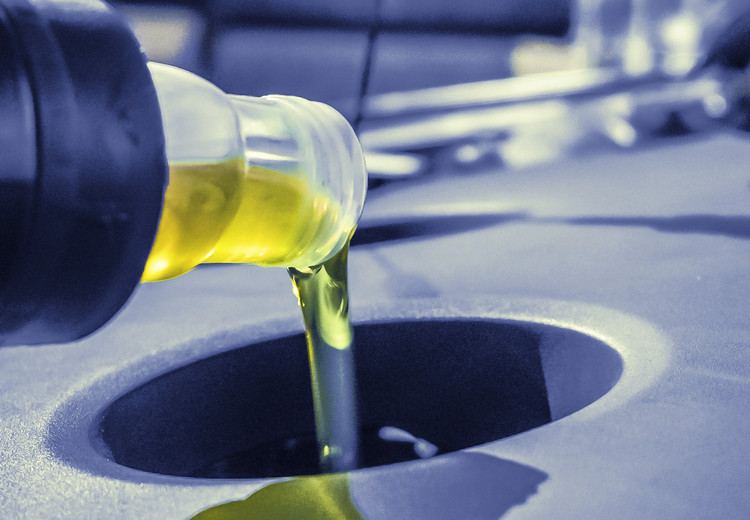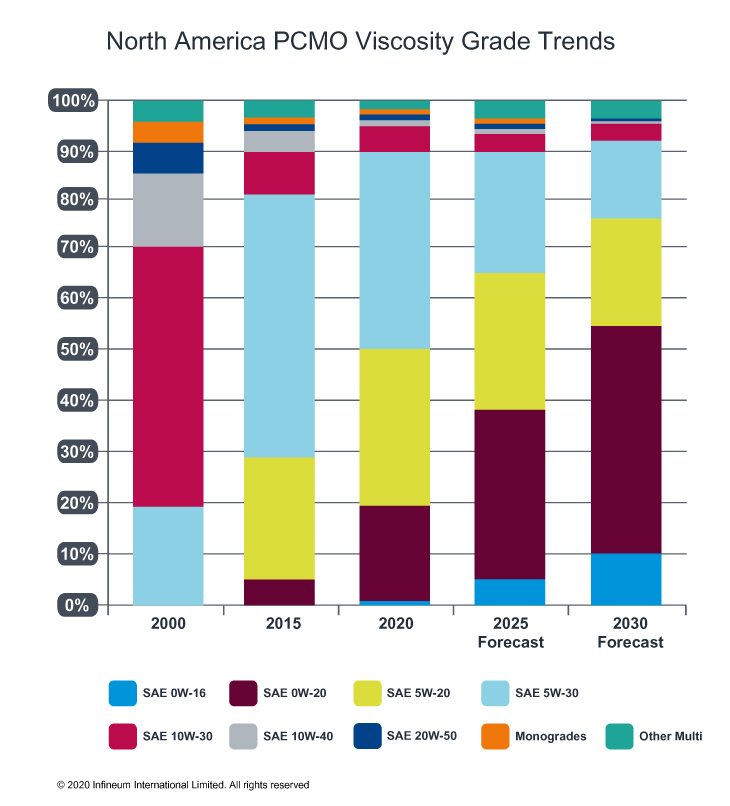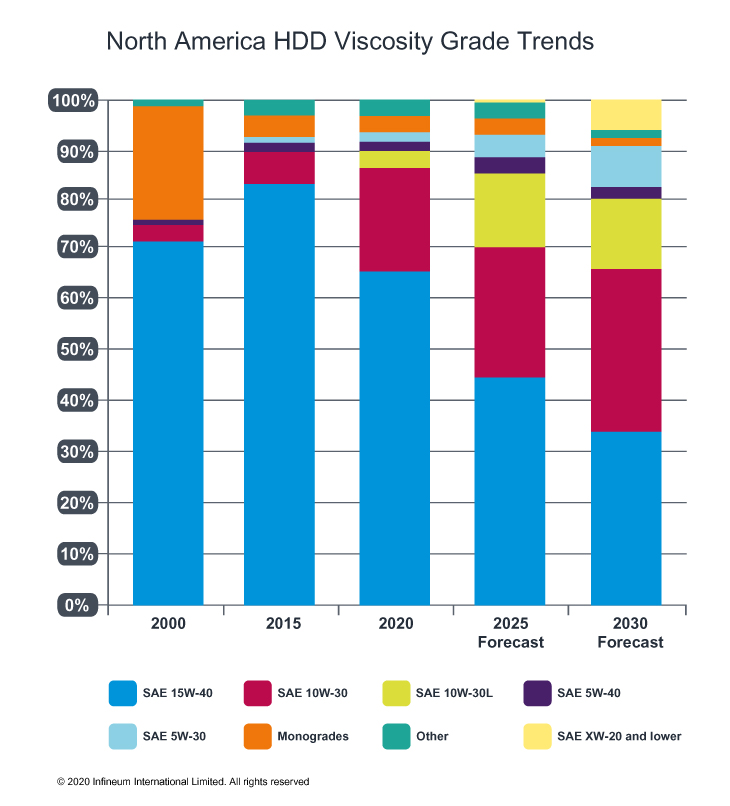Lubricant trends
India shining bright
16 April 2024
23 June 2020
The latest on North American engine oil viscosity grade trends

Engine oil viscosity grade trends, which are crucial for accurate supply and demand forecasting, are surprisingly difficult to call. Jeff Thompson, North American Crankcase Market Manager, explores the factors influencing them and reveals some of the latest thinking from Infineum on the future for both passenger car and heavy-duty engine oils in North America.
Of all the lubricant-related questions Infineum receives, those concerning future SAE viscosity grade trends are some of the most common. Not surprising, since they are critical factors when supply planning for base stocks and viscosity modifiers, which means it is really important to get them right. On the surface this might seem straightforward but, since there are a wide range of factors that can influence them, these predictions are in reality very complex.
In North America in 2019, while new light-duty vehicle sales were down slightly at just over 17 million, sales of used cars hit a new record of 40.4 million. New cars generally use lower viscosities and therefore vehicle population age is one factor that impacts viscosity grade trends. With a car population estimated at some 270 million vehicles, this trend for increased used car sales will drive up the average car age as new sales try to push lower viscosities forward. This means the latest new gasoline engine oil recommendations for the lowest viscosities, makes up a smaller part of the total car parc.
Clearly the impact of the coronavirus disease (COVID-19), will exacerbate this situation and US light-duty sales in May 2020 were down more than 30% year on year.
Estimates will vary, but annual retirement of around 4% of the 270 million vehicles is reasonable and as the vehicle parc churns so do the viscosity grade recommendations. In most cases an SAE XW-20 recommendation is replacing SAE 5W-30 and thicker oil requirements.
New specifications are another influencing factor and always a major topic of discussion in industry. From January 1 2020, pre-registrations opened for the new, long awaited, API gasoline engine oil standard ILSAC GF-6. And, from May 1 2020, oil marketers could claim ILSAC GF-6A/API SP or GF-6B/API Resource Conserving (RC) and display the appropriate API certification mark. ILSAC GF-6B enables new fuel economy viscosity grades below SAE 0W-20 to be introduced with its own certification mark.
Although the North American market is likely to transition quite quickly to the new ILSAC GF-6 standard, in the main, only a small segment of new vehicles will use the lowest viscosity grade, SAE 0W-16.
This has a knock on effect in that, even if we look out ten years, volumes of fuel economy grades such as SAE 0W-16 could remain relatively small. This could change if OEMs build more engines that are designed for SAE 0W-16 and allow this grade in more of today’s engines, however this so far seems unlikely. We are seeing some movement by OEMs, such as Toyota, to suggest SAE 0W-16 in more vehicles during this model year but it lags behind the recommendations being made for lower viscosity in Japan. Car maintenance is also an important factor to consider. With a growing number of OEMs pushing customer subscriptions, we may see more dealer-based car servicing. This means that vehicles that could use SAE 0W-16 are more likely to be service filled with that grade during a dealer based service.
For maintenance outside of dealer control, consumers could use 3rd party service providers or carry out oil changes themselves. And, in these cases, despite the fact that good quality oil protects the engine there may be a tendency to select more conventional or higher viscosity oils rather than SAE 0W-XX and premium performance products if they are given the option and allowed.
Currently, in the North American passenger car motor oil (PCMO) market, SAE 5W-30 is the most common viscosity grade. Although it was first introduced as a more standard recommendation in the late 1980’s today it represents some 40% of oil sold, despite the fact that SAE 5W-20 and 0W-20 are the most widely recommended grades for the newest cars. Compared to the HDD market where users are very wary about using lower viscosities, even if they are recommended, PCMO moves more quickly. Looking out ten years, there is likely to be a fast decline for SAE 5W-30 and significant growth for SAE 0W-20. SAE 5W-20 sees some decline but it could be viewed as a transitionary grade to the eventual use of more SAE 0W-20.
SAE 0W-20 is expected to rise from some 20% today, becoming the most popular grade by 2025 and reaching close to 50% of oil sold in ten years.
Over the forecast period, SAE 0W-16 continues to be a niche grade, with no clear path yet for increased OEM use in North America until a majority of vehicles sold call for that viscosity grade.

In 2019, North American heavy-duty diesel (HDD) vehicle sales saw strong growth, reaching some 276,000. The vehicle parc is split some 60% being on-highway and 40% off highway, with each application having its own lubrication requirements. COVID-19 is impacting Class 8 sales, with orders in North America in May down 38% on the previous year. This, combined with a rush to cancel previous bookings, puts fewer of the latest technology trucks on the roads.
On the specification front, to support fuel economy drivers and the introduction of new emissions reduction hardware, API introduced CK-4 and FA-4 on December 1 2016. The new standards delivered improved aeration performance, wear and deposit protection, oxidation control and shear stability over API CJ-4. In addition, API FA-4 introduced fuel economy SAE XW-30 grades with high temperature high shear (HTHS) viscosity range of 2.9cP–3.2cP for on-highway applications. To date there have been 1,385 API CK-4 registrations, while API FA-4 registrations seem to have flattened out at 105.
In this market, SAE 15W-40 had been the workhorse viscosity grade for many years, but it has peaked and is forecast to decline to near 30% by 2029. And, although OEMs have been using SAE 10W-30 since API CJ-4 was introduced in 2006, it has until now had only a small market position. Looking ahead, since the fuel saving benefits of lower viscosity lubricants are considerable and OEM specifications are being introduced to support their use, the growth of lower viscosity grades should be significant. A rapid shift towards SAE 10W-30 is expected – especially in the on-highway sector. By 2029, SAE 10W-30 may account for ~40% of the market and high value SAE 5W-XX, although not reaching mainline volumes, could make ~10%. The growth of even lower SAE XW-20 volumes however looks likely to be a slow process that depends on further innovations by HDD OEMs.
HDD fleet owners and operators are becoming increasingly comfortable with API CK-4 SAE 10W-30 fluids but they are still hesitant to use lower viscosity API FA-4 if not explicitly supported across the entire fleet.
Even then, durability is crucial. The use of API FA-4 SAE 10W-30 will continue to be slow until entire fleets turn over such that OEMs specifically endorse API FA-4 fluids in those engines and auxiliary power units also support API FA-4 (or electrify!).
Volvo is set to introduce its VDS-5 specification in the near future that will be an 'FA-4 type' SAE 5W-30. This could drive some of the increase in the synthetic SAE 5W markets as well as provide some growth for API FA-4 fluid sales as customers become more comfortable with the viscosity grade. Since API FA-4 viscosities are a bit of a niche today, could oil marketers start to prefer selling a SAE 5W-30 API FA-4 instead of a SAE 10W-30 API FA-4 if they are going to sell an API FA-4 product at all? This will be an interesting area to watch as it unfolds.

In both PCMO and HDD applications it is essential that, in the quest for fuel economy, the introduction of lower viscosity grades does not compromise engine durability or emissions system compatibility. Additives are designed to ensure lubricants can function at much lower viscosities and retain their protective properties over ever extending drain intervals. New lubricants not only provide enhanced fuel economy via their viscometric and frictional properties but also enable the introduction of new engine technologies that provide significant increases in both fuel economy and engine performance under more extreme operating temperatures.
The trend to lighter viscosity grades impacts the scale and the shape of demand for viscosity modifiers.
Lighter grades generally require lower treat rates of viscosity modifier polymers, but the characteristics of these polymers will be critical to maximise fuel economy and both low and high temperature protection. Any drop in demand in developed markets that comes as a result of more narrow cross grading may be offset by overall growth in emerging markets. In addition, there is a trend for these markets to move away from monogrades (and heavier multigrades) to lighter multigrades that are common today in developed countries.
Predicting future viscosity trends requires a large amount of data, detailed market research and a high degree of insight. As pressures to curb CO2 emissions drive the automotive industry to further improve fuel economy we can expect the trend to lower viscosity engine oils to continue. In Japan, for example, the new ultra-low-viscosity gasoline passenger car engine oil specification JASO GLV-1 has been claimable since October 2019, which paves the way for the introduction of SAE 0W-8 oils. HDD OEMs see real fuel economy savings at potentially targeting SAE XW-20 and lower oils in future designs.
The question that remains is: just how fast and how far will this trend to low viscosity go?
While we can say with some certainty that no prediction on this topic is perfect, Infineum will continue to monitor the market to understand how quickly we shift but it is also investing to always be ready with the technology needed to support even the most extreme low viscosity needs.
Sign up to receive monthly updates via email